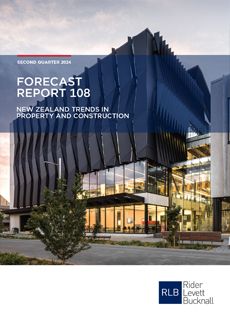According to the Rider Levett Bucknall (RLB) Forecast 108 report – New Zealand Trends in Property and Construction – construction activity remains weak, as a rebound in non-residential construction is offset by a decline in residential construction.
RLB Director Grant Watkins said, “This likely reflects the continued impact of higher interest rates and tighter access to finance, with uncertainty over how long interest rates will remain high.”
He added, “Although Auckland continues to lead the way in construction activity, there has been a plateau more recently. Nonetheless, Auckland continues to make up around 41 per cent of nationwide construction activity (on a nominal basis). The dominance of construction activity in Auckland reflects demand from migration-led population growth in the region.”
Meanwhile, Canterbury’s share of nationwide construction activity has trended higher since early 2022.
Number of dwelling consents easing
Forecast 108 found that although there was a rebound in dwelling consent issuance in the month of February, overall, the trend remains one of weak residential construction demand.
The annual number of dwelling consents issued eased further to be just over 36,200 for the year to February 2024. This weakness in residential construction remains broad-based across the building types.
Grant continued, “We expect demand for standalone houses will remain soft given the scarcity of centrally located land and increased development opportunities for medium density housing.”
Migration-led population growth to drive housing recovery
“Over the longer term, we expect intensification of housing to meet demand from strong migration-led population growth, will drive a recovery in demand for apartments and townhouses,” he said.
The weakness in residential construction has also been broad-based across the regions.
Residential construction demand in Auckland has fallen sharply since late 2022, with the annual number of dwelling consents issued totalling just over 15,200 for the year to February 2024 – 27 per cent below levels a year ago.
Decline in consent issuance in Wellington
There has also been a marked decline in dwelling consent issuance in Wellington more recently, with consent issuance totalling just 2,300 over the past year.
Uncertainty over the extent of cutbacks in the public sector will likely weigh on housing demand in Wellington for the coming year.
Over the longer term, RLB expects the recovery in residential construction demand will be led by Auckland, reflecting the concentration of migration inflows in the region. There is pessimism which reflects weak demand in the construction sector, with building sector firms reporting reduced output and new orders in the March quarter.
Building sector pricing pressures affecting profitability
This is weighing on pricing pressures in the sector, and the inability for firms to pass on higher costs by raising prices is driving a further deterioration in profitability in the building sector.
A net 77 per cent of building sector firms reported weaker profitability in the March quarter. These results suggest a further slowing in construction cost inflation over the coming year.
These results suggest the process for the construction of dwellings has been more prolonged in recent years, with delays likely over the COVID-19 pandemic period. However, there are emerging signs of an unwinding of these delays since late 2022.
Grant continued, “We expect that as capacity pressures in the construction sector continue to ease, this should see further improvement in terms of the time taken to complete the construction of dwellings.”
Increase in non-residential construction demand
According to Forecast 108, there was a sharp fall in consent issuance for education buildings for the year to February 2024. This decline was offset by increased demand for social, cultural and religious buildings and healthcare facilities over the past year.
Growth in consent issuance for retail outlets and industrial buildings also contributed to the increase in non-residential construction demand over the past year.
We expect the slowing in retail spending as households face higher mortgage repayments and softer labour market will weigh on construction demand for retail outlets.
Over the longer term, we continue to expect strong population growth, and the ageing population will support demand for new healthcare facilities.
Healthcare, social, cultural and religious buildings lead the way
Social, cultural and religious buildings and healthcare facilities led the growth in non-residential consent issuance over the past year. The increased demand for the construction of social, cultural and religious buildings largely reflected stronger demand in Canterbury and Wellington.
Nationwide, the growth was driven by demand for both new social, cultural and religious buildings and alterations.
Meanwhile, the strengthening demand for healthcare facilities was broad-based across the regions except Auckland, which saw a substantial decline in demand for healthcare facilities.
This weakness in Auckland was offset by stronger demand for the construction of storage and industrial buildings in the region.
Construction cost inflation to ease
Grant concluded, “RLB expects construction cost inflation to continue to ease over the coming years, reflecting the continued easing in capacity pressures in the sector. Building sector firms report a further easing in labour shortages.”
“We forecast annual non-residential construction cost inflation to ease to below 3 per cent in 2025. Beyond that, we expect a recovery in construction demand will underpin a lift in construction cost inflation over the longer term,” he added.
FURTHER INFORMATION:



